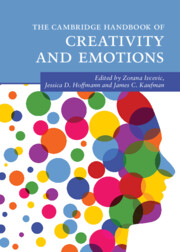35 results
Part III - Emotions and the Creative Person
-
- Book:
- The Cambridge Handbook of Creativity and Emotions
- Published online:
- 16 February 2023
- Print publication:
- 23 February 2023, pp 221-318
-
- Chapter
- Export citation
Part I - Methods in the Study of Creativity and Emotions
-
- Book:
- The Cambridge Handbook of Creativity and Emotions
- Published online:
- 16 February 2023
- Print publication:
- 23 February 2023, pp 9-84
-
- Chapter
- Export citation
32 - Creativity and Emotion
- from Part V - Emotions and Creativity at School and Work
-
-
- Book:
- The Cambridge Handbook of Creativity and Emotions
- Published online:
- 16 February 2023
- Print publication:
- 23 February 2023, pp 620-640
-
- Chapter
- Export citation
Tables
-
- Book:
- The Cambridge Handbook of Creativity and Emotions
- Published online:
- 16 February 2023
- Print publication:
- 23 February 2023, pp xi-xi
-
- Chapter
- Export citation
Dedications
-
- Book:
- The Cambridge Handbook of Creativity and Emotions
- Published online:
- 16 February 2023
- Print publication:
- 23 February 2023, pp v-vi
-
- Chapter
- Export citation
Creativity and Emotions
-
-
- Book:
- The Cambridge Handbook of Creativity and Emotions
- Published online:
- 16 February 2023
- Print publication:
- 23 February 2023, pp 1-8
-
- Chapter
- Export citation
Part IV - Emotions and Creative Products
-
- Book:
- The Cambridge Handbook of Creativity and Emotions
- Published online:
- 16 February 2023
- Print publication:
- 23 February 2023, pp 319-458
-
- Chapter
- Export citation
10 - Creativity and Emotional Intelligence
- from Part II - The Development of Creativity
-
-
- Book:
- The Cambridge Handbook of Creativity and Emotions
- Published online:
- 16 February 2023
- Print publication:
- 23 February 2023, pp 186-204
-
- Chapter
- Export citation
Part V - Emotions and Creativity at School and Work
-
- Book:
- The Cambridge Handbook of Creativity and Emotions
- Published online:
- 16 February 2023
- Print publication:
- 23 February 2023, pp 459-640
-
- Chapter
- Export citation
Contents
-
- Book:
- The Cambridge Handbook of Creativity and Emotions
- Published online:
- 16 February 2023
- Print publication:
- 23 February 2023, pp vii-ix
-
- Chapter
- Export citation
Copyright page
-
- Book:
- The Cambridge Handbook of Creativity and Emotions
- Published online:
- 16 February 2023
- Print publication:
- 23 February 2023, pp iv-iv
-
- Chapter
- Export citation
Figures
-
- Book:
- The Cambridge Handbook of Creativity and Emotions
- Published online:
- 16 February 2023
- Print publication:
- 23 February 2023, pp x-x
-
- Chapter
- Export citation
Contributors
-
- Book:
- The Cambridge Handbook of Creativity and Emotions
- Published online:
- 16 February 2023
- Print publication:
- 23 February 2023, pp xii-xiv
-
- Chapter
- Export citation
Acknowledgments
-
- Book:
- The Cambridge Handbook of Creativity and Emotions
- Published online:
- 16 February 2023
- Print publication:
- 23 February 2023, pp xv-xvi
-
- Chapter
- Export citation
Part II - The Development of Creativity
-
- Book:
- The Cambridge Handbook of Creativity and Emotions
- Published online:
- 16 February 2023
- Print publication:
- 23 February 2023, pp 85-220
-
- Chapter
- Export citation
Index
-
- Book:
- The Cambridge Handbook of Creativity and Emotions
- Published online:
- 16 February 2023
- Print publication:
- 23 February 2023, pp 641-658
-
- Chapter
- Export citation

The Cambridge Handbook of Creativity and Emotions
-
- Published online:
- 16 February 2023
- Print publication:
- 23 February 2023
Part II - The Development of Creativity
-
- Book:
- The Cambridge Handbook of Lifespan Development of Creativity
- Published online:
- 19 November 2021
- Print publication:
- 25 November 2021, pp 99-262
-
- Chapter
- Export citation
Acknowledgments
-
- Book:
- The Cambridge Handbook of Lifespan Development of Creativity
- Published online:
- 19 November 2021
- Print publication:
- 25 November 2021, pp xiv-xiv
-
- Chapter
- Export citation
Figures
-
- Book:
- The Cambridge Handbook of Lifespan Development of Creativity
- Published online:
- 19 November 2021
- Print publication:
- 25 November 2021, pp x-x
-
- Chapter
- Export citation

